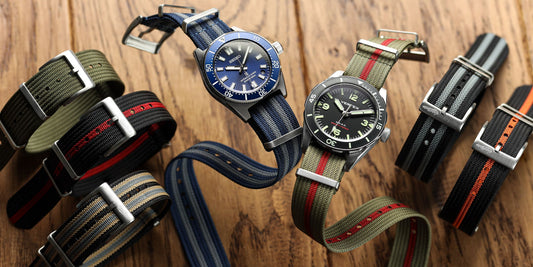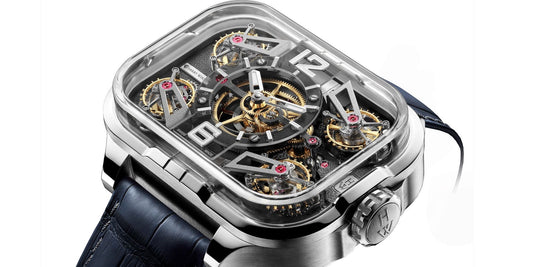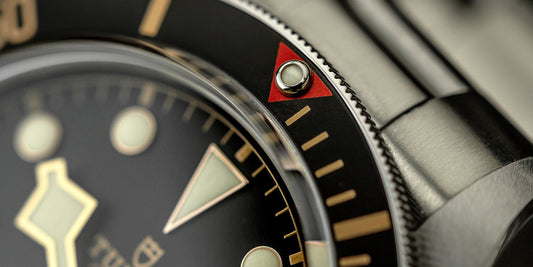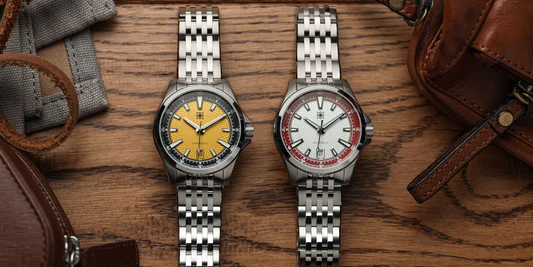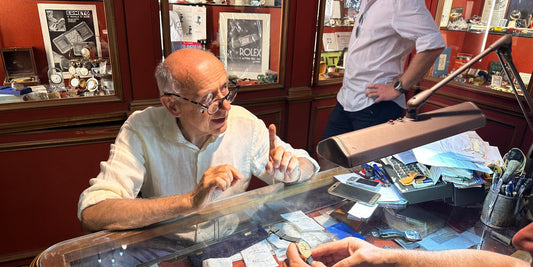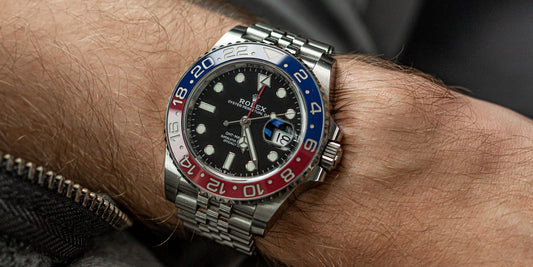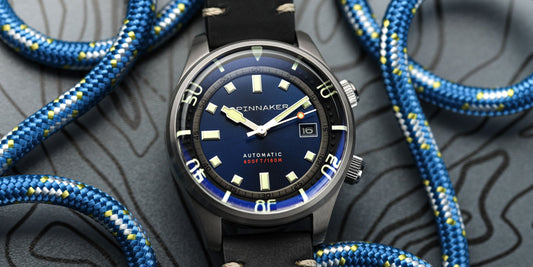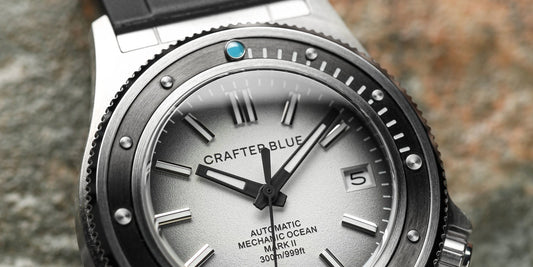From Russia With Love - A unique assignment for the Sierra Zero One Phalanx...
The idea was a simple one, or as simple as travelling to Russia in the heart of a pandemic could be. What would it be like to take a British military watch deep into the heart of the former Iron Curtain, in a place that’s officially classified as medically dangerous? With Covid-19 rates soaring in Russia and enough bureaucracy to put off most casual visitors, this was always going to be a challenging and slightly stressful mission. Russia is very different now to how it used to be, but there’s still a frisson of Cold War fear that you inevitably always feel on touching down in Soviet territory, helped by formidable officials hiding under huge peaked hats, and the legacy of several spy novels devoured as a kid. You hand over your passport open at the visa page, with a ream of accompanying paperwork – compiled in triplicate – which is necessary just to get into the country. The passport official takes it from you grudgingly then turns it over suspiciously, eyeing you carefully all the time. After minutes of slow, deliberate, scrutiny there’s an equally slow and deliberate Cyrillic stamp placed in your passport. With a dismissive nod of the peaked cap, you’re officially welcomed to Russia. And then it’s onto the next queue to claim your luggage, ready for a customs inspection.
That’s how your visit begins.
Taking your time
To get anything done in Russia, you need time on your hands. Trying to speed up officialdom is like attempting to stop an oil tanker: it’s just not going to happen – at least not quickly. That’s why you need a watch that’s going to faithfully measure the passage of time as you wait. Most things in Russia are functional. And because of that, there’s a strange minimalist beauty about many everyday objects: a bit like a Sputnik. You could almost call it utilitarian chic, if you were in an arty frame of mind. And the other reason why things generally aren’t too flashy in Russia – among ordinary people at least, although the oligarchs are more than happy to flaunt their wealth – is because there’s still an element of danger, however small.

The Geckota S-01 Phalanx - Image Credit: Geckota
Muggings do happen, and you just have to type ‘Russian road rage’ into YouTube to see how short a fuse many people there are on. You need to have stuff with you that’s discreet yet functional and hard. In the sense of ‘don’t mess with me’ as well as durable. Something that’s prosaic, useful, wears well and doesn’t attract attention. Which is why the new Geckota S-01 Phalanx, coated in black PVD, is the perfect companion for this mission. It’s a new military watch that’s just the right size at 41mm, sitting neatly and discreetly on the wrist. There’s a solid weight that always reminds you it’s there, but it doesn’t draw attention to itself. Which is a pity in some ways, as it’s worth paying attention to for its own sake. While it’s subtle and sits reasonably small, there’s a satisfyingly functional aesthetic about it that keeps you coming back to look again.

The Geckota S-01 Phalanx - Image Credit: Geckota
First and foremost, it’s eminently legible. With clearly laid-out and pleasingly stubby hands, you can tell the time at a glance – even more so in the dark, when the green lume (on orange hands) really makes the display stand out. Its military heritage is obvious, as wearing this watch on your wrist feels a bit like carrying a Swiss army knife in your pocket. You feel ready and prepared for more or less anything. It’s a watch that gives you confidence, as you know it’s not one that’s going to need to be looked after. Rather, it’s there to look after you. It’s a perfect travel companion, doing everything you need, wrapped up in a supremely tough case that takes no-nonsense. Its weight is at first surprising but then reassuring. In short, I was very glad to have it with me in Russia. I only took one watch with me, and it was my constant companion for a week, on every occasion. And it turned out to be one of those watches that fit into your travel plans seamlessly.
The name of the game
So where and what was this caper all about? Who in their right mind would go to Russia in the midst of a Covid crisis? The place was Sochi, on the shores of the Black Sea, which was the venue for the Russian Grand Prix in Formula 1. Travel to and from Russia is generally restricted, but Formula 1 gets an exemption. It might seem like an odd place to host a race, but there’s a good reason for that. Having hosted the Winter Olympics in February 2014, Sochi was left with a massive Olympic Park that turned out to be perfect for a grand prix. Nearby were some top hotels, the Black Sea, a 207-metre bungee jump, an Irish pub called O’Sullivan’s and even Stalin’s dacha (now a museum). Everything a visitor could possibly want, in other words. True, there were some unusual aspects to the facilities in Sochi: especially the ‘double toilet’ cubicles, which meant that you could go with a friend. But the other ultra-modern facilities more than made up for this, meaning that the Russian Grand Prix still felt a little bit like spending a weekend in a science-fiction novel. Which is exactly why you need a stealthy and utterly grounded watch.
Up close and personal
A confession, first of all. I’ve never actually liked military style straps much. Each to their own, and all that. But there’s something about a black and grey striped military style – a classic combination if there ever was one – which suits the look of this watch perfectly. In particular, the canvas ensures it's hugged tightly to your wrist, which is where it belongs: ready for service. So it’s already achieved something that I thought was nearly impossible at the start of my time with it: turned me into a military style convert. A conventional strap would almost seem fussy in this context.

The S-01 Phalanx in Russia - Image Credit: Anthony Peacock
It also provides a blank canvas (so to speak) for the strong visual identity of the watch, allowing all the details – in particular the red-tipped second hand – to shine through. The overall look is a perfect blend of ancient and modern: the hands and case size recalling a bygone military age, but the numerals and chunky bezel feeling thoroughly up to date. The whole ensemble works very cohesively, with the thick case making the Phalanx feel seemingly indestructible. Just the thing you want to take on a trip to Russia in other words: a land that’s definitely rough and ready, particularly when you get into the hinterland. The military theme is echoed in everyday life: there aren’t many countries that have so many policemen and officials in obvious attendance. Many older Russian watches, such as Vostoks, actually have a slightly similar look to this Phalanx – so it blends into the scenery well.
Racing in Russia

The F1 in Russia - Image Credit: Anthony Peacock
Hosting a Formula 1 race in Russia might seem like quite a modern idea, or at least one that came about following the fall of the Berlin Wall. But the idea dates back a full 40 years. Bernie Ecclestone thought of it first, round about the time of the Olympic Games in Moscow in 1980.
Those Olympic games ended up being boycotted by a number of nations as a protest against the Soviet invasion of Afghanistan. Like we said, the militia is never far away in Russia. But Ecclestone wanted to succeed where the Olympic Games had failed.
Shortly after those Olympics, Ecclestone met the Soviet leader, Leonid Brezhnev, who happened to be a keen car collector. But Ecclestone’s dream of seeing Formula 1 cars race in the shadow of the Kremlin died along with Brezhnev himself in 1982. It wasn’t until 1992 that Russian citizens could even watch F1 on television: the concept was previously considered too decadent.

The Red Bull F1 Car - Image Credit: WatchGecko Online Magazine
Not all Russian officials were quick to dismiss Formula 1 though. One of them – a sports fan with a judo black belt – wanted to bring F1 to his native city of Saint Petersburg. His name was Vladimir Putin, but back then he wasn’t quite famous enough to make it happen.
In the end, the project only came to fruition when Sochi – a seaside resort on the Black Sea – was awarded the rights to host the 2014 Winter Olympics. With an entire Olympic Park going begging, it made sense to have a Russian Grand Prix there too.
It’s ironic that a project that was first inspired by an Olympic Games back in 1980 needed another Olympics 24 years later to finally happen. The next round of negotiations began under the supervision of Putin – who was by then President – and a definitive deal was struck in October 2010. At long last, Formula 1 had arrived in Russia. And so had we: complete with our Phalanx.
Dacha-ing through the snow

Stalin’s Dacha - Image Credit: Anthony Peacock
The highlight of my trip wasn’t the race though. Instead it was a visit to Stalin’s dacha. First a bit of background: a dacha is a summer house, enjoyed by the elite in Russia. Stalin, while ostensibly a man of the people, had several of them scattered around Russia – in order to take a break from the onerous demands of being a full-time despot. The dacha he kept near Sochi is located in the middle of a forest and painted green, to disguise it from curious onlookers (it’s still hard to find today). And no wonder he wanted to keep it secret. A committed Communist probably isn’t supposed to have a private swimming pool and billiards room. Not to mention a suite of rooms for private bodyguards, who of course were made up of military personnel. Stalin’s bedroom – or rather the diminutive size of his bed – demonstrates how short he was in reality (make of that what you will) while his office looks like it’s not been touched since his death in 1953.

Stalin’s Dacha - Image Credit: Anthony Peacock
In this environment, the Phalanx seems perfectly at home. There are military maps, army radios, pressed uniforms and lots of khaki. Even some surveillance devices on Stalin’s old desk, the purposes of which aren’t entirely clear but probably quite sinister. It might not be exactly the sort of endorsement we are after, but the Phalanx wouldn’t have looked out of place sat on Stalin’s (small) wrist. He certainly wouldn’t have suited a bigger watch, although a cursory look around the dacha reveals that his aesthetic tastes were about as dubious as his style of government.
Nonetheless, there was something definitely thrilling about exploring Stalin’s house with the Phalanx, as if on a covert operation. A man who looked distinctly like a KGB agent outside only added to the atmosphere. Russian houses tend to be dark and dimly lit, so the clarity of the Phalanx and its luminescence was greatly appreciated.
The story behind the Phalanx
The consultant to the design of the Phalanx has a long-standing background with the Special Forces and his influence can be seen in practicalities such as the offset crown, for example, to ensure full movement of your hands, and decimal time on the outer dial – often used during military operations. There are other touches as well, such as dual luminescence colours with a different bezel marker compared to the dial, for accurate use at night. In short, you can feel the special forces pedigree of this watch every time you wear it, which is somewhat reassuring.The movement is an ETA 2824-2, which ensures that it’s going to be as dependable on the inside as it is on the outside. It’s hard to find just one word to describe the multi-faceted capabilities of this ‘blackout’ steel watch, but perhaps the right one would be ‘purposeful’.

The Geckota S-01 Phalanx - Image Credit: Geckota
The trip to Russia proved that you can genuinely use a bit of military heritage even as a normal person when you’re heading to an environment that’s a bit marginal, for whatever reason. Combining looks, discretion, and practicality, the Geckota S-01 Phalanx is a great addition to the family. Especially when travelling to Russia.




